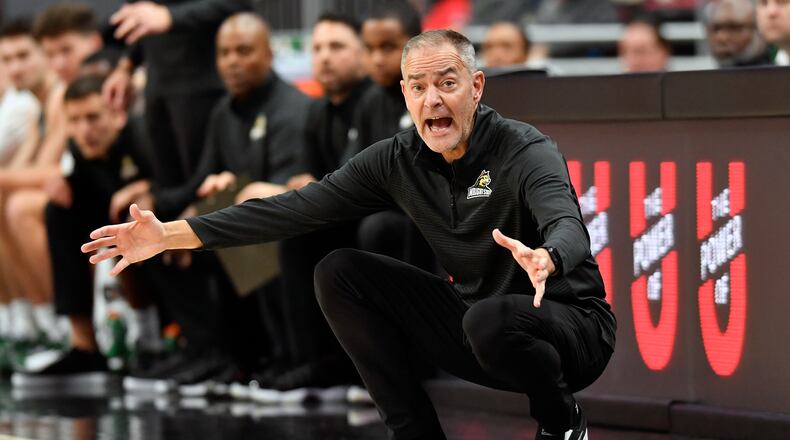But so far this season, the Raiders are doing neither, which is why they’re lugging a 5-6 record into Saturday’s home game against NAIA foe Northwestern Ohio.
Having put an emphasis on defense in recent weeks, Nagy seems to have shored up that phase of the game. But the offense is lagging behind.
During their current four-game losing streak, the Raiders have scored 59, 77, 60 and 54 points. As Nagy has acknowledged, it’s too much to ask of a defense to make up for those meager totals.
They’re shooting just 32.5% on 3′s, which is on pace for their lowest clip since hitting 32.3% in 2008-09.
They’re also making only 5.0 per game, their fewest since finishing with a mere 4.3 in 2005-06.
Asked what the “sweet spot” for him would be from 3, Nagy said: “The sweet spot for me is to shoot 40%. That’s what I’d like the team to do. That’s what I always tell players: ‘If you’re not shooting 40%, you need to take better ones or take less of them.’
“It’s not easy to shoot 40%, but you’re by yourself. It’s simple to shoot 70 or 80% (alone in a gym). We’re just trying to get to that point.”
The Raiders went into the weekend 239th out of 352 teams in 3-point percentage and tied for 333rd in 3′s per game. Their 15.4 attempts were 344th.
“We’re not telling our guys NOT to shoot them. We’re trying to be purposeful about where we get the ball. We’d like to take the ones that involve going inside-out — whether that’s off the drive or throwing it in the post (and then kicking it out),” he said.
“We’ve always been a post-oriented team. We like to throw it in to everybody, not just our post players. But I do think we need to shoot it better from there because teams are starting to tighten it up (inside defensively).”
Since its inception in 1986, the 3 has grown into more and more of a priority for teams — mostly because of the increased payoff.
If a player goes 2 of 5 from the field, he’s shooting 40%. But if those two buckets are 3′s, he’s essentially shooting 60%.
That’s called “effective field-goal percentage,” and the Raiders are getting hurt there, too.
They’re an impressive 27th nationally at 49.1% in pure field-goal shooting. Factoring in the 3, and they jump to 53.1%, but that’s only 113th in the nation because most teams are capitalizing much more from long range.
That’s why the school of thought among most coaches is to sprinkle in a heathy amount of 3′s.
But Nagy said: “I’m not into schools of thought. I agree that if you shoot 33% from 3, it’s like shooting 50% from 2. Just count the points. But you don’t get to the free-throw line. And if you want the most points per possession, then go to the free-throw line.
“If you shoot a bunch of 3′s, you’re not going to shoot free throws.”
The Raiders are hitting just 66.9% on foul shots, which is on pace for their worst showing since their 66.1% mark in 1997-98. That puts them 271st nationally.
They’re also averaging only 9.0 free throws made and 13.5 attempted, which is 333rd and 335th, respectively, in the country, putting them ahead of fewer than 20 Division-I teams.
The Raiders may be committed to feeding players on the blocks, but they’re not getting much return on their investment.
“We haven’t really shot a lot of free throws this year, which has been a little frustrating,” Nagy said. “If we could go to the free-throw line every time down the floor, that’s like shooting 70%. I would take that.”
Nagy is right. If 10 offensive possessions produced 20 free throws, the average mark of 70% would generate 14 points (or seven two-point field goals).
“The analytics and all that — how often you get to the free throw line might be the most important factor in winning,” Nagy said.
SATURDAY’S GAME
Northwestern Ohio at Wright State, 3 p.m., ESPN+, 980
About the Author
